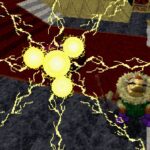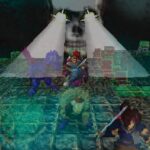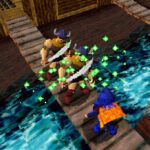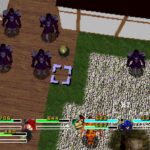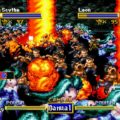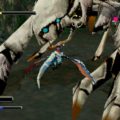Developer: Micro Cabin Publisher: Sega Released: 1996 Genre: Strategy RPG
The start of the 32-bit generation was rough for RPG fans. After receiving classic after classic in the final years of the SNES and Genesis fans suffered an awful drought. The few early RPGs that did release were garbage like Beyond the Beyond and Virtual Hydlide. One of the few respectable games from that period is Sega’s Mystaria: the Realms of Lore, a tactical RPG that was localized surprisingly quickly. This is no Shining Force but it scratches that same itch. Saturn RPG fans should check this out.
Ten years ago twelve warriors came together to stop the evil Bane from conquering the continent of Mystaria. While they were successful Bane simply retreated to plan for another day. Now Bane has returned but the twelve heroes who stopped him the first time are no more. He begins his conquest in Queensland and easily subjugates it with his five generals. But Prince Aragon escapes and now must assemble twelve warriors of his own to save his country. Mystaria does not have a complicated plot and there is some light character development. Unfortunately the game has a bad localization and is full of typos and grammatical errors that get worse as you progress. Luckily the gameplay makes up for it.
Although Mystaria is a tactical RPG it follows the structure of your typical RPG. The game has towns, an over world, and even random battles. These battles choose a random three members of your party and are over just as quickly as a traditional turn based game. The structure is incredibly free form. Once you have finished the initial few battles you can freely explore nearly the entire world at your leisure. The goal is to assemble all twelve members of your party but the order is up to you. Some are harder to reach than others but ultimately it does not take too long to assemble the full lineup. In addition to the mandatory dungeons and such there are a few side quests to tackle as well. Honestly I’m surprised at how full featured the game is as most early RPGS play it safe and lack ambition.
Strategy games live and die by their characters and abilities and Mystaria does not disappoint. The large cast covers a variety of character classes from archers to priests. Rather than a small selection of spells and skills earned over time every character learns a large pool of skills, of which 9 can be active. These range from typical healing and attack spells to cool terrain deformation. The list is incredibly diverse and one hero can even steal skills from enemies to distribute amongst your party. While certain classes are over represented (archers) there is enough diversity in the cast to make each battle feel unique.
A common complaint within the strategy RPG genre is that battles take too long. Mystaria largely bucks that trend. Although the number of enemies per battle can reach up to twenty to your max party of six they are brisk. Most skills are too powerful and with plenty that hit multiple enemies. Raiko in particular becomes game breaking in short order and is mandatory in every battle. While it does not get as granular as Final Fantasy Tactics when factoring in terrain and elemental advantages they are in the game. The only time the game drags is when you face multiple battles in succession with no chance to heal in between. But these moments are few. Overall I would say the difficulty is low outside of one brutal difficulty spike toward the end. For those that do not like the pace of the genre Mystaria is very accessible.
As much as I like the game you are not playing Mystaria for its production values. This is an ugly game, no doubt. I felt this way when it was initially released and time has not been kind. Mystaria uses pre-rendered sprites on 3d backgrounds for a stylish look. But in practice it is a hideous mess. The art direction is terrible and is obviously part of the generation that just learned how to make pre-rendered art. The terrain is detailed but suffers from heavy pixelation that makes the game confusing to look at at times. But the worst has to be the subpar framerate. There are many cool spell effects and special attacks but these drop the framerate so low at times the game practically stops. This is a first generation game and it shows.
In Closing
Mystaria serves as a nice appetizer for the later Shining Force III and is a good game in its own right. It exhibits the growing pains typical of games from that era but overcomes most of them to be a solid game in the end. I enjoyed revisiting this one, something I can’t say for many games of that period.


